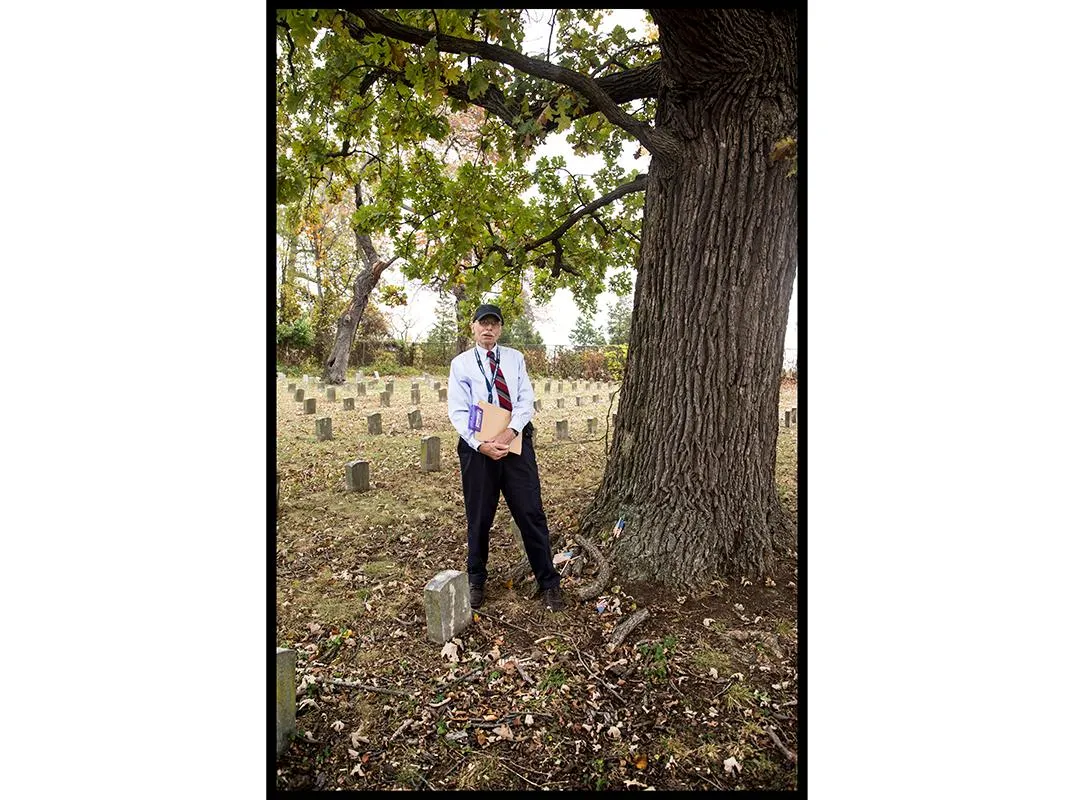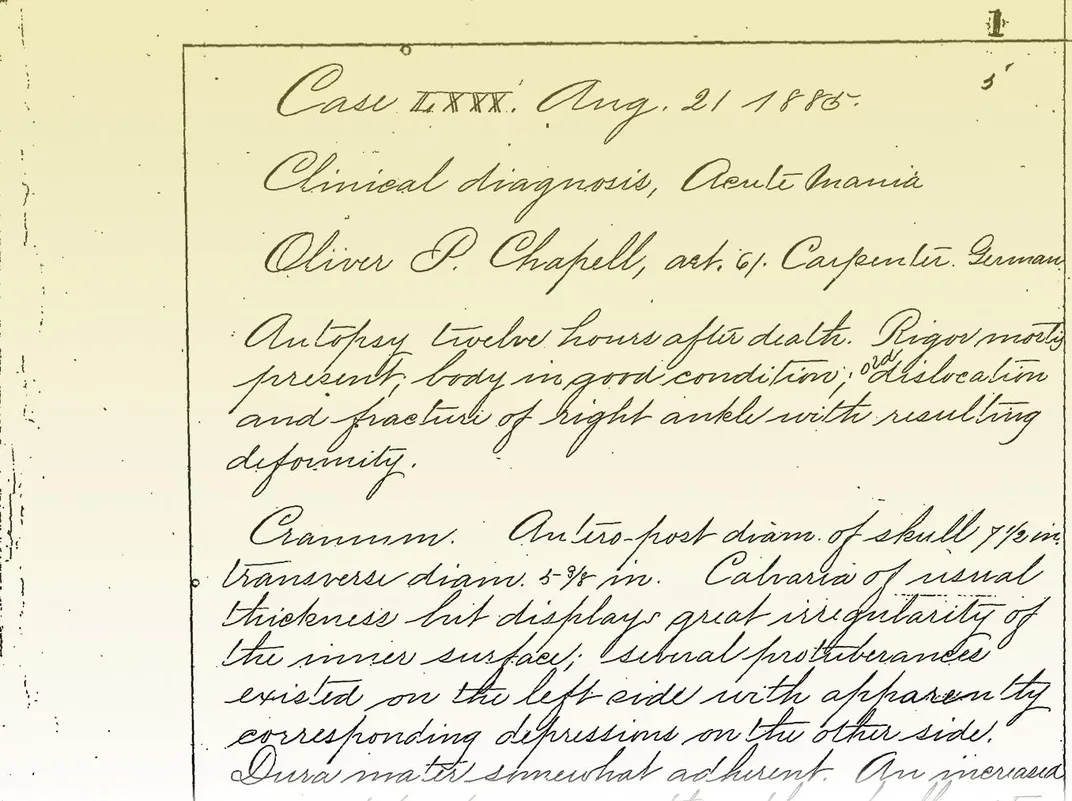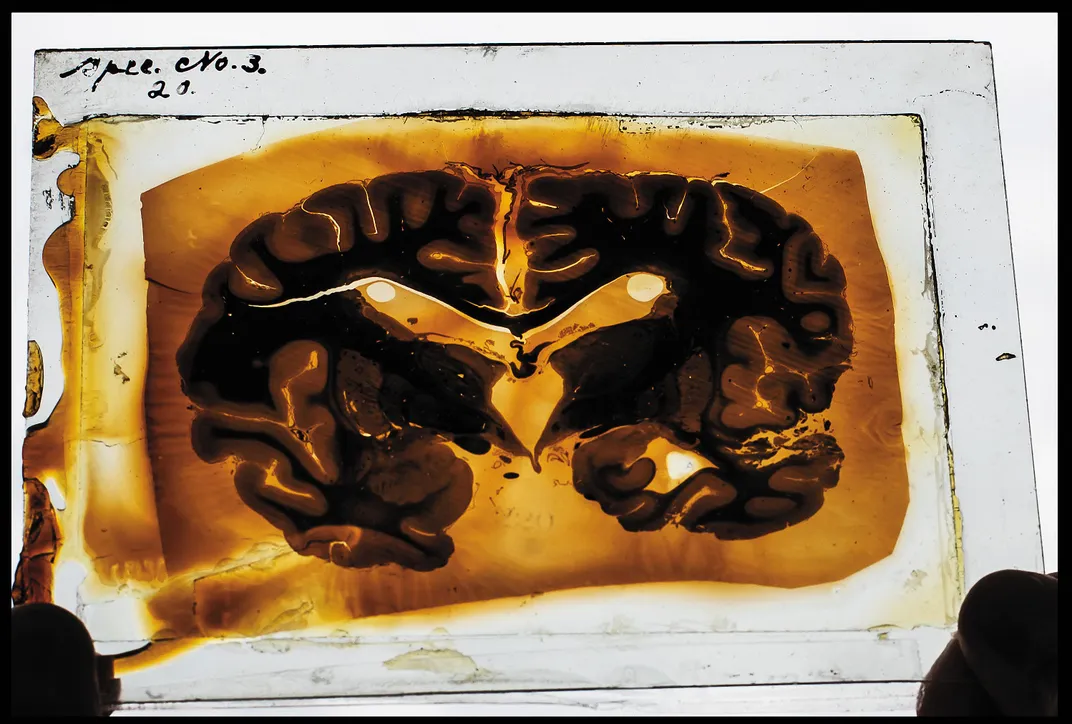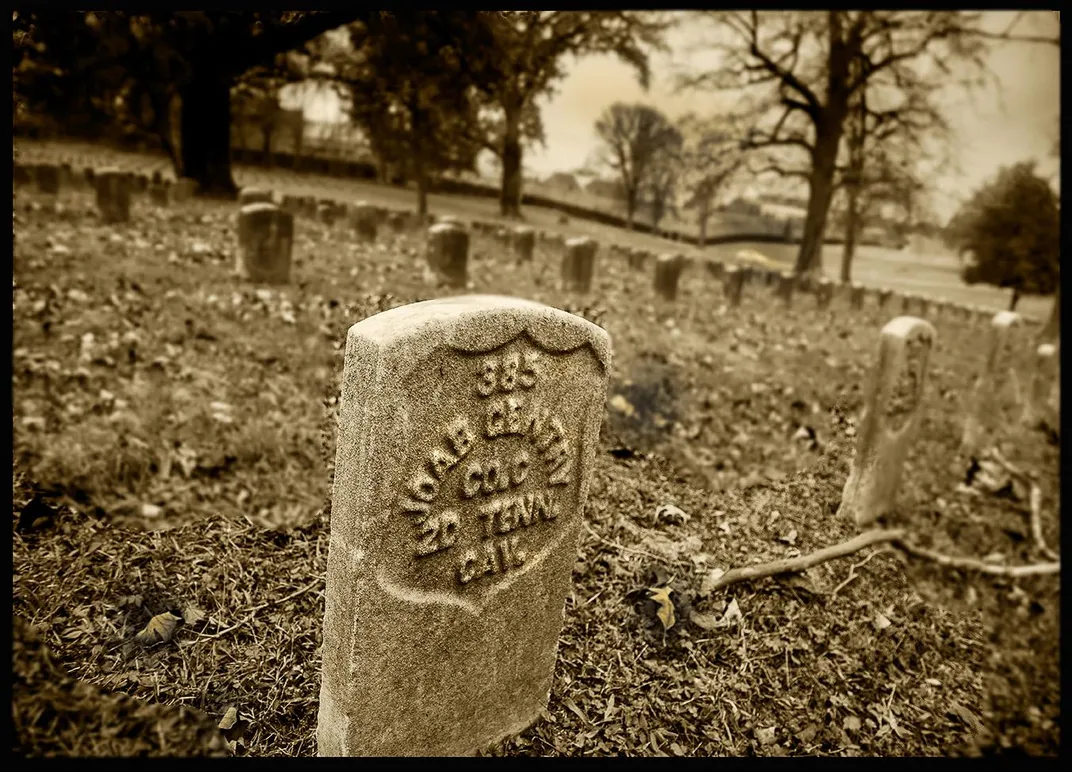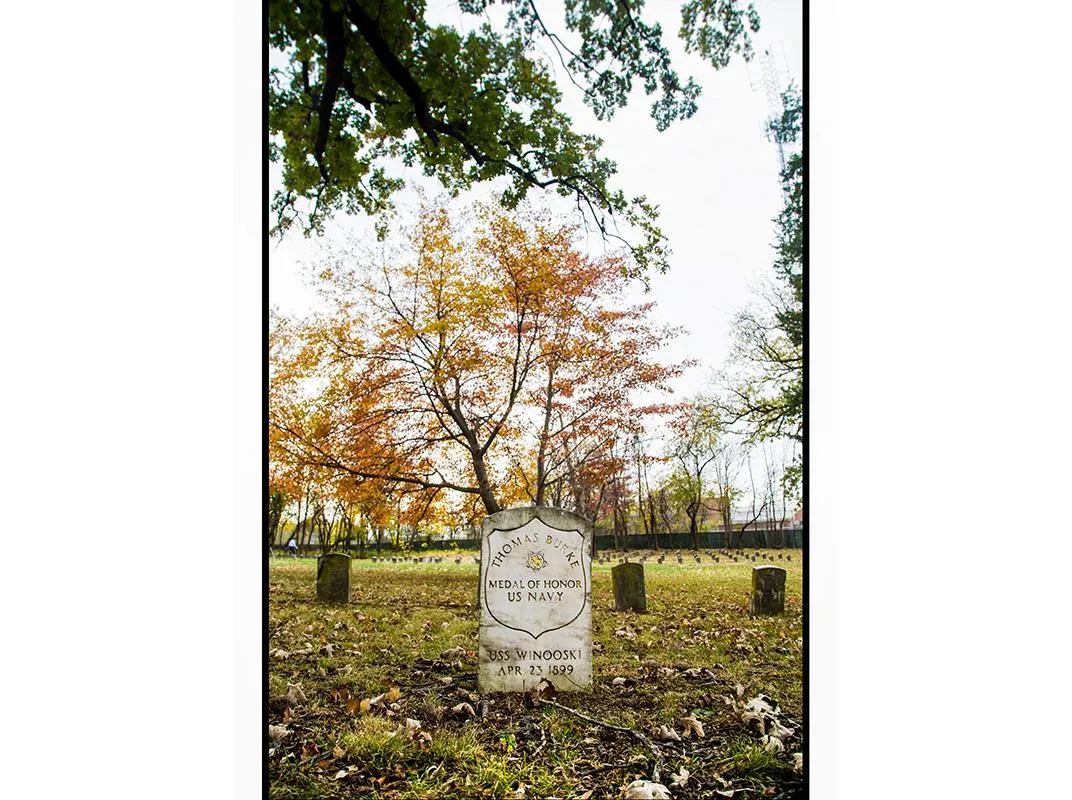Did Civil War Soldiers Have PTSD?
One hundred and fifty years later, historians are discovering some of the earliest known cases of post-traumatic stress disorder
/https://tf-cmsv2-smithsonianmag-media.s3.amazonaws.com/filer/37/7e/377e4911-852e-4170-a24f-00c7e0e7cc4f/dec15_f02_ptsd.jpg)
In the summer of 1862, John Hildt lost a limb. Then he lost his mind.
The 25-year-old corporal from Michigan saw combat for the first time at the Seven Days Battle in Virginia, where he was shot in the right arm. Doctors amputated his shattered limb close to the shoulder, causing a severe hemorrhage. Hildt survived his physical wound but was transferred to the Government Hospital for the Insane in Washington D.C., suffering from “acute mania.”
Hildt, a laborer who’d risen quickly in the ranks, had no prior history of mental illness, and his siblings wrote to the asylum expressing surprise that “his mind could not be restored to its original state.” But months and then years passed, without improvement. Hildt remained withdrawn, apathetic, and at times so “excited and disturbed” that he hit other patients at the asylum. He finally died there in 1911—casualty of a war he’d volunteered to fight a half-century before.
The Civil War killed and injured over a million Americans, roughly a third of all those who served. This grim tally, however, doesn’t include the conflict’s psychic wounds. Military and medical officials in the 1860s had little grasp of how war can scar minds as well as bodies. Mental ills were also a source of shame, especially for soldiers bred on Victorian notions of manliness and courage. For the most part, the stories of veterans like Hildt have languished in archives and asylum files for over a century, neglected by both historians and descendants.
This veil is now lifting, in dramatic fashion, amid growing awareness of conditions like post-traumatic stress disorder. A year ago, the National Museum of Civil War Medicine mounted its first exhibit on mental health, including displays on PTSD and suicide in the 1860s. Historians and clinicians are sifting through diaries, letters, hospital and pension files and putting Billy Yank and Johnny Reb on the couch as never before. Genealogists have joined in, rediscovering forgotten ancestors and visiting their graves in asylum cemeteries.
“We’ve tended to see soldiers in the 1860s as stoic and heroic—monuments to duty, honor and sacrifice,” says Lesley Gordon, editor of Civil War History, a leading academic journal that recently devoted a special issue to wartime trauma. “It’s taken a long time to recognize all the soldiers who came home broken by war, just as men and women do today.”
Counting these casualties and diagnosing their afflictions, however, present considerable challenges. The Civil War occurred in an era when modern psychiatric terms and understanding didn’t yet exist. Men who exhibited what today would be termed war-related anxieties were thought to have character flaws or underlying physical problems. For instance, constricted breath and palpitations—a condition called “soldier’s heart” or “irritable heart”—was blamed on exertion or knapsack straps drawn too tightly across soldiers’ chests. In asylum records, one frequently listed “cause” of mental breakdown is “masturbation.”
Also, while all wars are scarring, the circumstances of each can wound psyches in different ways. The relentless trench warfare and artillery bombardments of World War I gave rise to “shell shock” as well as “gas hysteria,” a panic prompted by fear of poison gas attacks. Long campaigns in later conflicts brought recognition that all soldiers have a breaking point, causing “combat fatigue” and “old sergeant’s syndrome.” In Vietnam, the line between civilians and combatants blurred, drug abuse was rampant and veterans returned home to an often-hostile public. In Iraq and Afghanistan, improvised explosive devices put soldiers and support personnel at constant risk of death, dismemberment and traumatic brain injury away from the front.
Civil War combat, by comparison, was concentrated and personal, featuring large-scale battles in which bullets rather than bombs or missiles caused over 90 percent of the carnage. Most troops fought on foot, marching in tight formation and firing at relatively close range, as they had in Napoleonic times. But by the 1860s, they wielded newly accurate and deadly rifles, as well as improved cannons. As a result, units were often cut down en masse, showering survivors with the blood, brains and body parts of their comrades.
Many soldiers regarded the aftermath of battle as even more horrific, describing landscapes so body-strewn that one could cross them without touching the ground. When over 5,000 Confederates fell in a failed assault at Malvern Hill in Virginia, a Union colonel wrote: “A third of them were dead or dying, but enough were alive to give the field a singularly crawling effect.”
Wounded men who survived combat were subject to pre-modern medicine, including tens of thousands of amputations with unsterilized instruments. Contrary to stereotype, soldiers didn’t often bite on bullets as doctors sawed off arms and legs. Opiates were widely available and generously dispensed for pain and other ills, causing another problem: drug addiction.
Nor were bullets and shells the only or greatest threat to Civil War soldiers. Disease killed twice as many men as combat. During long stretches in crowded and unsanitary camps, men were haunted by the prospect of agonizing and inglorious death away from the battlefield; diarrhea was among the most common killers.
Though geographically less distant from home than soldiers in foreign wars, most Civil War servicemen were farm boys, in their teens or early 20s, who had rarely if ever traveled far from family and familiar surrounds. Enlistments typically lasted three years and in contrast to today, soldiers couldn’t phone or Skype with loved ones.
These conditions contributed to what Civil War doctors called “nostalgia,” a centuries-old term for despair and homesickness so severe that soldiers became listless and emaciated and sometimes died. Military and medical officials recognized nostalgia as a serious “camp disease,” but generally blamed it on “feeble will,” “moral turpitude” and inactivity in camp. Few sufferers were discharged or granted furloughs, and the recommended treatment was drilling and shaming of “nostalgic” soldiers—or, better yet, “the excitement of an active campaign,” meaning combat.
At war’s end, the emotional toll on returning soldiers was often compounded by physical wounds and lingering ailments such as rheumatism, malaria and chronic diarrhea. While it’s impossible to put a number on this suffering, historian Lesley Gordon followed the men of a single unit, the 16th Connecticut regiment, from home to war and back again and found “the war had a very long and devastating reach.”
The men of the 16th had only just been mustered in 1862, and barely trained, when they were ordered into battle at Antietam, the bloodiest day of combat in U.S. history. The raw recruits rushed straight into a Confederate crossfire and then broke and ran, suffering 25 percent casualties within minutes. “We were murdered,” one soldier wrote.
In a later battle, almost all the men of the 16th were captured and sent to the notorious Confederate prison at Andersonville, where a third of them died from disease, exposure and starvation. Upon returning home, many of the survivors became invalids, emotionally numb, or abusive of family. Alfred Avery, traumatized at Antietam, was described as “more or less irrational as long as he lived.” William Hancock, who had gone off to war “a strong young man,” his sister wrote, returned so “broken in body and mind” that he didn’t know his own name. Wallace Woodford flailed in his sleep, dreaming that he was still searching for food at Andersonville. He perished at age 22, and was buried beneath a headstone that reads: “8 months a sufferer in Rebel prison; He came home to die.”
Others carried on for years before killing themselves or being committed to insane asylums. Gordon was also struck by how often the veterans of the 16th returned in their diaries and letters to the twin horrors of Antietam and Andersonville. “They’re haunted by what happened until the end of their lives,” she says.
Gordon’s new book on the 16th, A Broken Regiment, is but one of many recent studies that underscore the war’s toll on soldiers. In another, Living Hell: The Dark Side of the Civil War, historian Michael Adams states on the first page that his book describes “the vicious nature of combat, the terrible infliction of physical and mental wounds, the misery of soldiers living amid corpses, filth, and flies.”
Not all scholars applaud this trend, which includes new scholarship on subjects such as rape, torture and guerrilla atrocities. “All these dark elements describe the margins not the mainstream of Civil War experience,” says Gary Gallagher, a historian at the University of Virginia who has authored and edited over 30 books on the war. While he welcomes the fresh research, he worries that readers may come away with a distorted perception of the overall conflict. The vast majority of soldiers, he adds, weren’t traumatized and went on to have productive postwar lives.
Gallagher and others also warn against viewing 1860s Americans through too contemporary a lens. As a rule, Civil War soldiers were more religious than Americans today, more imbued with notions of honor and glory, and less inclined to share their pain or seek help for it. They returned to a society without a Veterans Administration or G.I. Bill or modern pharmacology. These and many other factors “make it very hard to apply 21st-century diagnostics to 19th-century data,” says Stephen Goldman, a neuropsychiatrist who has treated veterans and is writing a book about the impact of war on soldiers in the Civil War and other conflicts.
Even so, there are striking instances of Civil War soldiers afflicted in ways that appear similar to the experience of veterans today. PTSD didn’t enter the medical lexicon until 1980, but its symptoms—including flashbacks, panic attacks, insomnia and suicidal thoughts—turn up frequently among Civil War soldiers, particularly those who entered asylums. In Shook Over Hell, historian Eric Dean examined the records of 291 Civil War veterans admitted to the Indiana Hospital for the Insane and found cases like Elijah Boswell, who “Sobbed & cried & imagined that some one was going to kill him,” screaming “the rebels was after him.”
Others were brought to the asylum because they barricaded themselves in rooms, awake all night with weapons at the ready. A veteran who narrowly survived an artillery barrage would shout at his wife, “Don’t you hear them bombarding?” Another, shot in the side during the war, was described upon admission as sleepless, suicidal and convinced “he is bleeding to death from imaginary wounds.”
Asylum records also give painful glimpses of families struggling to understand and help shattered loved ones. Patient files from the Government Hospital for the Insane in Washington, now known as St. Elizabeths, are filled with letters to the superintendent, like this one from a shopkeeper in Pennsylvania. “If brother is in any way conscious of passing events, I should like him to know that I have his oldest son Jimmy with me in the store, that he is a good boy and smart.” A Massachusetts woman wrote of her father, “If he does know anything at times please tell him his daughter has written to you about him and also give him my love.”
The brother of John Hildt, the Michigan soldier who lost his arm and sanity after the Seven Days Battle, wrote a letter in their native German, in hopes “he will recognize any thing I say to him. He is John Hildt Corporal Co K 1st Michigan Vol.” Hildt’s family also sought a pension for both his physical and mental disability. The latter claim was denied, the pension office wrote, due to “lack of proof” that Hildt became insane due to his wartime service and wounding.
Doctors were more sympathetic but unable to do much for the veterans in their care. Treatment consisted mainly of “moral therapy,” a regime of rest and light labor in the hospital gardens, which perched atop what was once a peaceful and bucolic hilltop in Anacostia. Doctors also administered opiates, stimulants and “tonics,” such as a punch made of milk, eggs, sugar and whiskey. All this may have provided temporary relief to patients. But most Civil War veterans who entered the asylum never left it.
One file includes a photograph of the patient, in old age, still wearing his uniform four decades after being admitted at the end of the Civil War with “Acute Suicidal Melancholia.” Often, the last item in a patient’s file is a telegram like the one sent to a Massachusetts woman in 1900. “Your husband died this afternoon. Shall we bury here? Answer?”
Hundreds of Civil War soldiers are among those buried at St. Elizabeths, in two cemeteries that were little visited and became overgrown in the course of the 20th century. Now, this too has changed as families rediscover long-forgotten forebears and come to visit their graves.
“A lot of the old stigma is gone,” says Jogues Prandoni, a volunteer at St. Elizabeths who helps families research their forebears and locate graves. “People hear about troubled veterans of Iraq and Afghanistan and want to know about and honor ancestors who may have suffered in the same way.”
Among the many genealogists he’s guided is Marti Bourjaily, a Coloradan whose family tree includes an lumberman from Maine and young volunteer in an infantry regiment that fought at Antietam, Gettysburg and other major battles. Edward Leard was wounded in the eye, deserted several times and suffered a mental collapse after returning to Maine at war’s end. Sent first to a state hospital, he was transferred to St. Elizabeths and died there at the age of 54 with $18 to his name.
The surviving records don’t reveal much about Leard’s affliction. But Bourjaily wonders if he was like her own father, who stepped on a land mine at the Battle of the Bulge, watched a friend die while trying to save him and was “pumped up on morphine” before returning home, where he drank heavily and “ranted” about his wartime experience throughout her childhood.
“They didn’t have phrases like ‘post-traumatic stress disorder’ in the Civil War, they just thought these shattered guys were sissies, the sort that George Patton would have slapped across the face,” she says. “Soldiers come back different people, that was true with my dad and I’m sure it was with Edward Leard. I want to reach out to this man and tell him how sorry I am that he had to go through hell.”
Gail Palmer, a retired newspaper reporter in Florida, has also come to view the Civil War and her own family through fresh eyes. She took up genealogy while caring for her Alzheimer’s-afflicted mother—“I decided to join her back where she was, in the past”—and anticipated researching the many prominent people she’d been told about, dating back to the Revolution. “No one ever mentioned Oliver Perry Chappell,” she says.
An infantry captain from New York, Chappell fought in several battles before being wounded and captured at Chancellorsville and sent to a Confederate prison. Upon his release, he wandered and struggled, changing jobs and spouses and becoming indigent before entering the Government Hospital for the Insane, where he died in 1885. Palmer learned of his fate only after finding an application for a soldier’s tombstone in his name, which led her to the asylum.
“I was stunned,” she says. “All I’d heard about were my wealthy and successful ancestors who belonged to yacht clubs and the DAR and appeared in the society pages.”
This lineage includes three other great-grandfathers who served in the Union Army. Palmer says all of them appear to have settled down and prospered, and her research has led her to suspect that Oliver Chappell’s instability predated the Civil War. “I’m not real confident how together he was in the first place, but how together are any of us?” she wonders. “We might skate through life if nothing terrible happens, but we fall apart if it does.”
Whatever Chappell’s mental state, Palmer is proud to welcome him back to the family. She’s taken what she calls a “pilgrimage” to St. Elizabeths and the National Archives to learn more about her great-grandfather and has posted her research on Ancestry.com.
“Oliver’s the most interesting ancestor I’ve got,” she says. “Maybe, finally, we’re far enough away from the Civil War to tell the painful stories that families like mine covered up.”
Related Reads
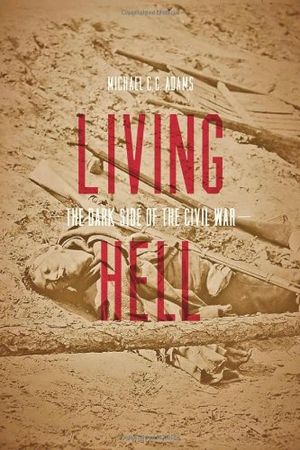
Living Hell: The Dark Side of the Civil War
